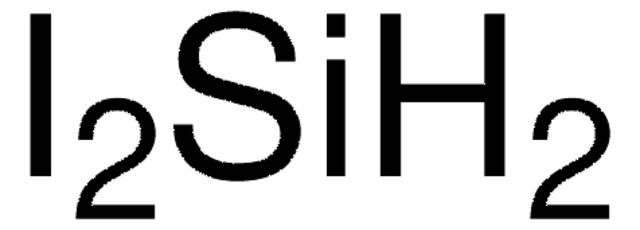175552
Trichlorosilane
99%
Synonym(s):
Hydrotrichlorosilane, Silicochloroform, Silicon chloride hydride, Trichloromonosilane
About This Item
Recommended Products
vapor density
1 (vs air)
Quality Level
vapor pressure
9.75 psi ( 20 °C)
Assay
99%
form
liquid
expl. lim.
70 %
bp
32-34 °C (lit.)
density
1.342 g/mL at 25 °C (lit.)
storage temp.
2-8°C
SMILES string
Cl[SiH](Cl)Cl
InChI
1S/Cl3HSi/c1-4(2)3/h4H
InChI key
ZDHXKXAHOVTTAH-UHFFFAOYSA-N
Looking for similar products? Visit Product Comparison Guide
Related Categories
General description
Application
Other possible applications:
- Asymmetric reduction of N-aryl ketimines in the presence of a novel
L-valine-derived catalyst to form secondary amines.
- Hydrosilylation of imidazolinones to form chiral imidazolidinones in the presence of a 2,2′-bispyrrolidine based Lewis base organocatalyst.
- Trichlorosilane activated with chiral N-formylproline
derivatives is an effective reagent for the reduction of imines to form
enantiomerically enriched amines.
- Trichlorosilane reacts with dimethylformamide to form hypervalent hydridosilicates, which can reduce aldehydes to alcohols, imines to amines, and also for the reductive amination of aldehydes.
Signal Word
Danger
Hazard Statements
Precautionary Statements
Hazard Classifications
Acute Tox. 3 Inhalation - Acute Tox. 4 Oral - Eye Dam. 1 - Flam. Liq. 1 - Skin Corr. 1A - Water-react 1
Supplementary Hazards
Storage Class Code
4.3 - Hazardous materials which set free flammable gases upon contact with water
WGK
WGK 1
Flash Point(F)
<-2.2 °F - Equilibrium method
Flash Point(C)
< -19 °C - Equilibrium method
Personal Protective Equipment
Certificates of Analysis (COA)
Search for Certificates of Analysis (COA) by entering the products Lot/Batch Number. Lot and Batch Numbers can be found on a product’s label following the words ‘Lot’ or ‘Batch’.
Already Own This Product?
Find documentation for the products that you have recently purchased in the Document Library.
Customers Also Viewed
Our team of scientists has experience in all areas of research including Life Science, Material Science, Chemical Synthesis, Chromatography, Analytical and many others.
Contact Technical Service












